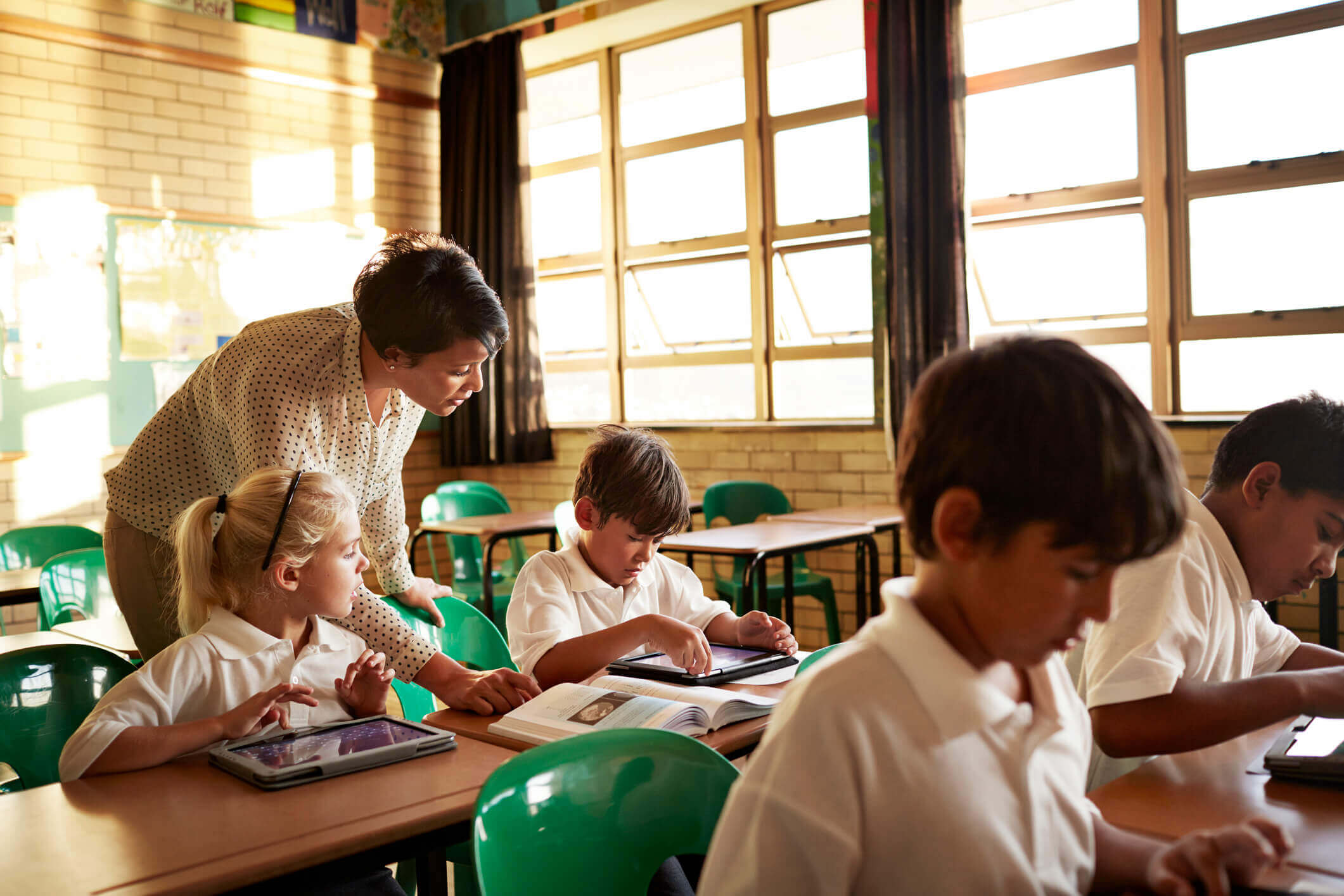Published on March 8th, 2023
How to Use Interactive Whiteboards in Higher Education
11 minute read

With the emergence of new technologies to enhance the teaching process, there is a huge push for professional development among educators. This means it’s time to throw your old teaching practices and techniques out the window and leverage technology to enhance learning.
The interactive whiteboard – also known as an interactive display or smart panel – has revolutionised the way that lectures are delivered and digested in higher education. But using them to your advantage does require planning and execution in order to maximise their effectiveness as a learning aid.
In this article, we will explore five top tips for using this powerful teaching and learning tool among university and higher education learners. Get ready to enhance your students’ learning experience!
5 tips for using interactive whiteboards in higher education institutions
1) Don’t be afraid to use multimedia in your lesson plans
One of the best ways to transform your lesson plans and boost student engagement is to incorporate multimedia. Pictures, videos, and audio clips are all useful tools for making lessons more comprehensive and helping students retain information more effectively. They can also consolidate students’ understanding of more complex subjects, enabling them to reach their full potential.
Multimedia can help to grab the attention of your students, which creates interest and allows them to focus on the content of the lesson. As well as boosting engagement across entire student cohorts in higher education, there is a wealth of evidence to suggest that interactive technologies can help to boost academic achievement.
In a higher education setting, stress levels can be high. So, students might often be more focused on simply learning their coursework rather than understanding it. Multimedia lessons are a good way to simplify complex content, and visual aids can help students to visualise otherwise complicated study material. It can walk them through the content from its basic foundations to the end result or solution, making it easier for university students to leave classrooms and lecture theatres with a solid understanding of their course content.
2) Encourage collaboration and participation
As an educator, you’re always chasing the key to student achievement. Time and time again, we return to the idea of student engagement as the way to ensure the top grades and the best possible performance.
Interactive whiteboards are fantastic tools to help educators get their students involved in their lessons. Rather than sitting and listening to an hour-long lecture, students can participate in their lessons and collaborate with their peers more effectively.
Here are a few ways to use your digital whiteboard for better collaboration and participation:
- Encourage group discussions and teamwork. You can divide your students into smaller groups and assign a task to each group. Using the whiteboard, each group can then present their work to their peers. Then, allow time for constructive feedback, debates, and discussions.
- Liven things up. Instead of forcing your students to perform mundane, monotonous, or otherwise boring tasks, you can use your whiteboard as a way to liven things up. Use polls, quizzes, and games to make teaching and learning more interactive and fun.
- Improve remote learning. Remote students can easily zone out of a lesson when they’re doing nothing but staring at a screen. An electronic whiteboard can enhance digital learning by encouraging participation for these students. As a result, your teaching will be more effective.
3) Add notes and explanations
Another great way to use your interactive whiteboard in higher education settings is to add notes and explanations to your lessons in real-time. This allows you to explain and clarify complex concepts, give your students additional context, and jot down any examples you may have used during your class.
When you’re adding notes to your interactive whiteboard, consider what it is you’re trying to convey to your students. It may be essential concepts, graphs, diagrams, or any other visual aids you want your students to remember.
The idea of adding notes and explanations is closely related to using multimedia in your lessons as well. Not only can you expand on the information within the media, but it helps to build on the foundational knowledge of the media and provide more context to your content.
With interactive whiteboards, you can also save and reuse these notes and explanations. Similarly, you can share the updated notes directly with your students! This saves you time, effort, and resources. And it allows you to focus on what really matters: delivering effective and engaging lectures and seminars to your students!
4) Switch up your instructional techniques
Using an interactive whiteboard in higher education allows course leaders to switch up their student engagement strategies. This can help to create a more dynamic and engaging learning environment for your students.
Additionally, you can use the whiteboard to meet the different needs of your students. As most of them have unique learning styles, changing things up can make for a fresh and exciting learning experience.
One of the best ways to change up your instructional techniques is to plan lectures and seminars around different learning styles. There’s no one-size-fits-all approach to learning – some of your lecture class will be more visual learners, while others will prefer audio or kinaesthetic styles of teaching. University lectures already have a reputation for being one-dimensional, so switching up your teaching style will ensure your class are listening and learning. This can involve using different assessment methods and getting students out of their seats in interactive learning, perhaps using an interactive whiteboard as an aide.
5) Stay engaged with your students
Ultimately, having a fully engaged lecture hall is the optimal way to encourage learning and ensure success. Gone are the days of explaining concepts with your back to your class. Using remote controls with your interactive whiteboard enables educators to keep their focus on their students and engage more directly with them than ever before.
Digital learning can also feel impersonal at times, since everything is projected or displayed on screens and tablets. But you can change the way your students perceive your lessons by focusing on providing more personable body language and eye contact. This simply isn’t possible with a standard whiteboard, as lecturers will have to face the board when writing and gesturing to information.
Final thoughts
As you can see, an interactive whiteboard is not only a tool to aid teachers and learners. It can completely revolutionise lessons in higher education settings!
By incorporating Promethean interactive whiteboards into the classroom, educators can create an environment in which learners can learn more easily. If you’re considering adding an interactive whiteboard to your classroom, request a demo from us today!
FAQs
What are the three key advantages of interactive whiteboards in the classroom?
The three main benefits of using an interactive whiteboard in the classroom are:
- Promoting student engagement. An interactive whiteboard allows students to interact directly with their teachers and peers. This allows for more effective and efficient student learning in any classroom.
- Flexibility. With so many online and remote learning facilities, a traditional whiteboard simply won’t cut it. Interactive whiteboards allow educators to share their learning tools and study materials directly with their students. This includes any notes they may have made during their lessons.
- Enhanced learning. An interactive whiteboard can enable students with different learning styles to learn more efficiently. With the integration of visual, audio, and tactile tools, every group of students can benefit from this classroom technology.
What instructional techniques can you implement with interactive whiteboards?
The three primary instructional techniques that are most effective include:
- Multimedia lessons. Including video and audio in your lessons can help students to actively engage with their study materials.
- Collaboration and problem-solving. Students have a better opportunity and provide input during their lessons.
- Presentation aids. Students can use a smart whiteboard to enhance their presentations and projects. This may also encourage other students to be more engaging and focused during peer presentations.
How can interactive whiteboards keep learners engaged in the lesson?
By using the same technologies that students are familiar with, teachers and educators can relate to them on a more engaging and interactive level. The ability to collaborate and use an interactive whiteboard for various teaching methods helps to keep them focused. It also improves students’ attitudes toward the learning process.




